Ancient Buddha Statues of Kerala
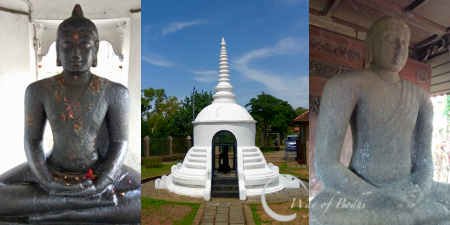
Many ancient Buddha statues, dating back to 6th Century CE were discovered from various parts of Kerala. During their glorious period, for many centuries, these statues would have inspired an entire populace. From their inner space of calmness and compassion, these Buddha statues smile to the world even today as the embodiment of peace, sublime thought, and the excellence of intellectual climate that prevailed in the region in the foregone eras. These idols reveal that there existed a culture in Kerala too that derived inspiration from the words of the Buddha and transcended the barriers of caste and dogmatic thinking.
Let us be clear about a fact right from the beginning. The foundation of Buddhism is not in statues or any other icons, but in awakening oneself to Buddhahood. Buddhists find delight in working beyond religious frameworks with wakeful awareness and a blossoming heart. The role of statues are only in instilling in us the qualities that the Buddha embodied – peace, compassion, clarity of mind and the triumph over emotions. It is never to be taken as another object of attachment and negative emotions. Even if there are no statues, a Buddhist can pursue his/ her path to awakening. The greater significance of these statues is rather in understanding the history of Kerala. These statues should be preserved as fitting memorials of our heritage.
These Buddha statues also tell some stories.
Firstly, most of the discovered statues are from the period 6th to 9th century CE. That means, there were Buddha statues in Kerala before and after Sankaracharya of Advaitha darshana. Further, the history of the renowned Sreemoolavasa indicates that Buddhism flourished well in Kerala even in the 11th Century. From these, it is clear that the popular story about Sankaracharya defeating Buddhists in philosophical debate and making them run away is just a cooked up one with no basis. (Further, no strong arguments are found in the works of Shankara that can defeat the Buddhists in their philosophical view.) It is more likely that Buddhism vanished from Kerala in the 12th – 14th century CE after the decline of Ay, Ezhimala and Kulashekhara kingdoms.
Another fact is that, most of these statues were found from temple ponds. Temples in Kerala are called Anpalam (anpu+alam). In Tamil (the language of Kerala too on those days) the meaning of anpu is loving-kindness and the meaning of alam is place. So Anpalam means the ‘place of loving-kindness’. Later when Buddhism declined and Kerala became infested with the disease and madness of caste and religious divisions, these statues were most probably shifted from the temple sanctums to the temple ponds outside. Even today, the temples of Kerala, in contrast with other parts of India, continues to be called Anpalam/ Kshetram. This may be due to the continuation of the Buddhist influence in culture and language. In Mahayana Buddhist literature, Kshetra (domain, field, dwelling place) is widely used to denote Buddhakshetra (dwelling place of the Buddhas), Punyakshetra (the field towards which meritorious deeds are performed) etc.
Another interesting fact is that most of the Buddha statues were found around the old kingdom of ‘Onattukara’ that had its capital at Mavelikkara. Onam and its legends associated with king Maveli even now fill the minds of Keralites with the memories of a foregone era of equality, truthfulness and righteousness. This may not be a mere coincidence. It may be indicative of a kingdom ruled with the Buddhist ethos of “abandon negativity, abide in wholesome deeds and perfectly conquer one’s own mind”. Possibly, the regions of Onattukara and Kollam would have been the places where the lamp of Dharma had its final glimmerings before its complete fading away from the land of Kerala.
Most of the places from where these statues are discovered have some locality or pond named as ‘Pallikkal’. In ancient times, the word ‘Palli’ was used in Kerala to denote Buddhist monasteries. There are at least three more places in Kerala with the name Pallikkal. It may be worthwhile to conduct some archeological investigations and excavation in the ponds and nearby areas there in search of historic remnants of Buddhism in Kerala.
The details about the seven statues that we visited are given below –
- From Pallikkal pond in Maruthoorkulangara, Karunagapalli (Kollam district) – Presently kept in Krishnapuram Palce, Kayamkulam.
- From Pallikkal 11 km west of Adoor (Kollam district) – Presently kept in Napier Museum, Thiruvananthapuram.
- From Thazhathukulakkada in Mannadi (Pathanamthitta distric) – Presently kept in Veluthampi Dalawa Memorial in Mannadi.
- From Pallikkal 5.5 km east of Kayamkulam (Alappuzha district) – Now kept in the compound of Bharanikkavu Devi Temple.
- From Kandiyoor Temple pond (Alappuzha district) – Presently kept in the Buddha junction near Shrikrishna Temple, Mavelikkara.
- From 4.7 km east of Ambalappuzha – (Alappuzha district) – Presently kept in Karumadi.
- From Kottapuram in Kodugalloor (Thrissur district) – Presently kept in the Directorate of Archeology, Thiruvananthapuram.
Maruthurkulangara (Krishnapuram palace Museum, Kayamkulam)
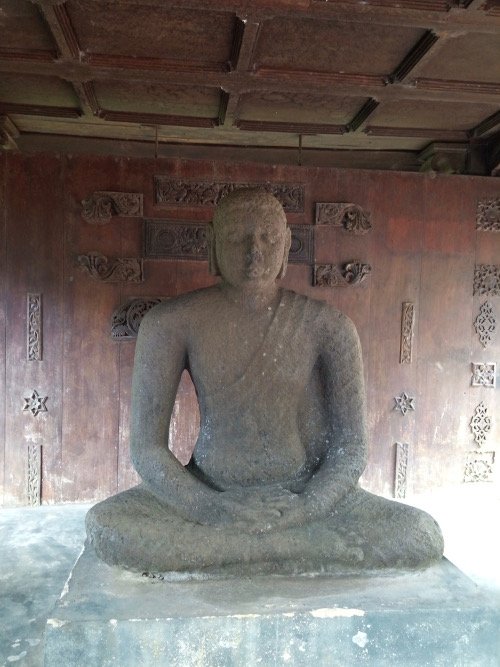
This Buddha statue, around 4 ft in height, is nicely preserved in the garden of Krishnapuram palace Museum in Kayamkulam. This was discovered around a century back from the Pallikkal pond in Maruthoorkulangara in Karunagapalli (Kollam district). Known from then on as ‘Pallikkal puthran’, it was earlier kept in Padanayarkulangara. Later it was handed over to the archeological department and taken to Museum. This statue is significantly different from the other statues discovered from Kerala in its details. The upper robe is not folded up. It is similar in style to the Gandharan Buddha statues. From the style of sculpture it is clear that it was made in CE 6th – 7th century or before. The Pallikkal pond in Maruthoorkulangara, from where this statue was rediscovered, is now developed as a heritage park by the city corporation.
Pallikkal (Kattanam Bharanikkavu)
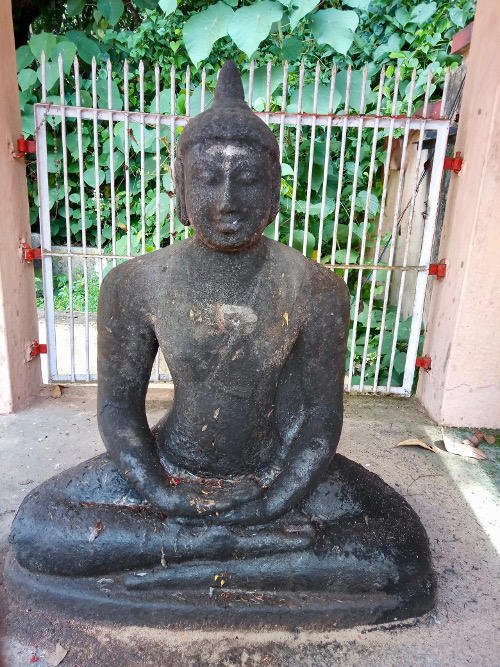
This statue, around 3 ft in height, is now kept in the compound of Bharanikkavu Devi Temple on the side of the Kurathikad-Kattanam road. It was discovered from a temple in Pallikkal, 5.5 km east of Kayamkulam. This statue has its upper robe folded and kept on the shoulder like most other Buddha statues in Kerala. From the style of sculpture, it can be inferred to be from 9th to 10th century CE. This statue is not preserved in a fitting way.
Mavelikkara

Mavelikkara Buddha 
Mavelikkara Buddha
This statue, around 3 ft in height, is presently kept in the Buddha junction near Shrikrishna Temple, Mavelikkara. It was discovered from the Temple pond of Kandiyoor Mahadeva Temple. This statue has upper robe folded and kept on the shoulder like most other Buddha statues in Kerala. From the style of the statue, it could be from the 9th to 10th century CE.
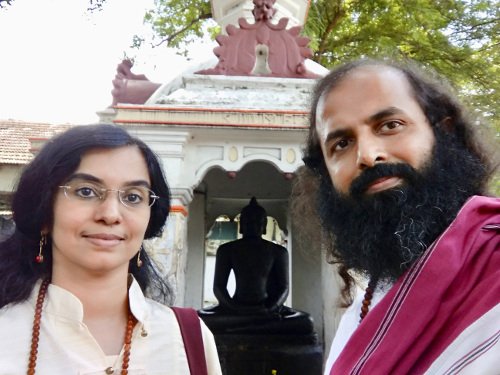
Karumadi, Ambalappuzha

Karumadi Buddha 
Karumadi Buddha
This half statue renowned as Karumadikuttan was the first statue rediscovered in Kerala. From the style of sculpture, it can inferred that it was made in the 8th century CE. When this statue was found from the fields of Karumadi more than a century ago, people had no idea that it was a Buddha statue. So, it was worshipped as a local god who protected the rice fields nearby. Later, upon identification of it as a Buddha statue, a beautiful Stupa structure in Srilankan style was made in a park and the statue was preserved there. Local people told us that HH Dalai Lama visited this statue long back and offered some money to build a stupa to preserve this statue. Though it is only a half statue, it is currently the best preserved Buddha statue in Kerala. It has also achieved some cultural significance compared to other Buddha statues.
Pallikkal, Kunnathoor (Thiruvananthapuram Napier Art Museum)
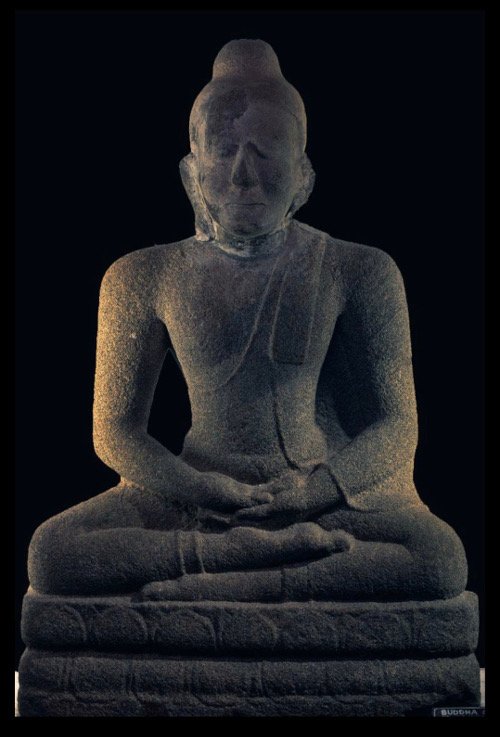
This Buddha statue, around 2.5 ft in height, was found from Pallikkal in Kunnathoor, 11 km west of Adoor. It was discovered in headless condition. The present head is a badly reconstructed substitute by the archeological department. From the style of the sculpture, it can be inferred to be from 9th to 10th century CE. It is presently kept in Napier Art Museum, Thiruvananthapuram.
Mannadi

Mannadi Buddha 
Mannadi Buddha
This statue was discovered from the sand-bed of the Kallada river near Mannadi by sand mining workers. It was later kept in Thazhathukulakkada public library grounds. In 2010 archeological department took over the statue and it is presently preserved in the Veluthampi Dalawa Memorial in Mannadi. This statue is around 2ft in height. Although it is identified by historians as a Buddha statue, some of its features are similar to that of Bodhisattva statues like the meditation-belt and ear rings. He is seated in ardhapadmasana and has Ushnisha and lotus seat. Most probably the broken right hand was in boon giving gesture (varada mudra).
Kottapuram, Kodungallor
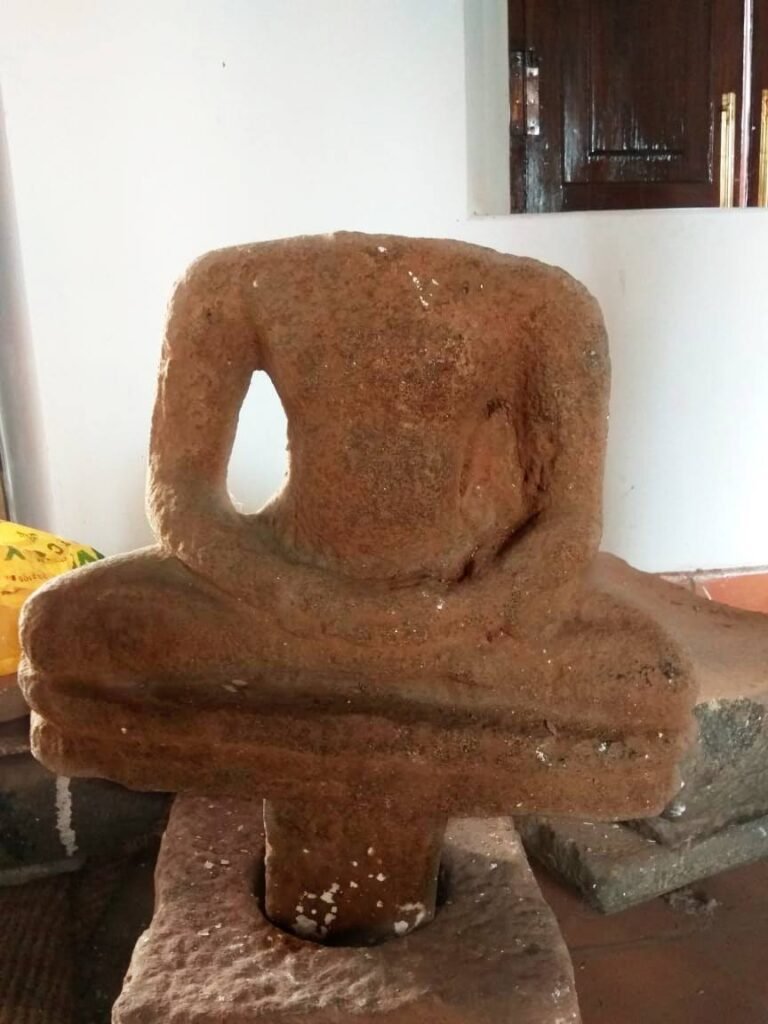
Buddha statue recently unearthed from Kottapuram in Kodungalloor (Thrissur district, Kerala) in a headless condition. Many historians consider Kodungalloor to be the location of Vanchi, a famed Buddhist centre of ancient Kerala. This small statue of about 1.5ft height is estimated to be from 8th to 9th century CE. It is presently kept in the reserve of Directorate of Archeology, Trivandrum.
A list of the other known Buddha statues of Kerala are given below.
More details will be added as and when we visit them.
- Buddha statue found in the banks of Varattar river near Mangalam Thevarkkadu Subrahmanya Temple near Chengannoor (Alappuzha district).
- Buddha statue in the Sree Thenkasinathan Temple, Kovilkadavu, Marayoor (Idukki district).
- Buddha statue recovered from Vellilapally in Kottayam district, and presently kept at the Sakthan Thampuran Archeological Museum, Thrissur.
- Buddha head recovered from Vellilapally in Kottayam district, and presently kept at the Hill Palace Museum, Ernakulam.
- Buddha statue kept in a house at Onampilli in Kaladi (Ernakulam district).
- Portions of a Buddha statue kept outside a temple in Nileshwaram, Pattanam (Ernakulam district).
- Like a bird flying through the vast expanse - September 21, 2021
- The Liberation Story of Punnika, a Girl from an Oppressed Caste - March 31, 2021
- Ancient Buddha Statues of Kerala - October 11, 2018


Great information, I am in the study of Buddhism in Kerala
Thank you !
Very informative description
Oh. Great
We are also..
Can we contact??
Vishnusr686@gmail.com
Congratulations Buddhism real study is Pali language where you will get true information about anciyindia cultural heritage and history.
Mahayani Buddhism is mostly in Sanskrit wherre most of the stories are glorified by verious Sangha’s
Satish, Yes, from the perspective of history of ancient India, Pali canon of Buddhism is definitely the most reliable source. The narrative contexts of Mahayana Sutras are often not directly historical in nature. However, they are beneficial in the path (Magga) .The narrations of the Buddha in Mahayana are meant to make it clear that Buddha is not just the body of a person, but the wisdom that he has awakened to, and that form is only a relative appearance. And, the Mahayana depictions of the activities of Buddha are often beyond our usual materialistic world-view (and hence not representations of our ordinary history). They are meant to open our minds to the vast expanse of wisdom where we transcend all kinds of clinging to matter and mind. It is also meant to inspire the practitioner to generate Bodhicitta – the altruistic intention of staying in Samsara and practicing towards full enlightenment for the benefit of all beings. It shows the inconceivable level of benefits a Buddha can bring to beings of all realms.
I am also involved in it
Let we contact
Oh. Great
We are also..
Can we contact??
Vishnusr686@gmail.com
There are more budha statues in Kerala
1. Veliyanoor banks of ithikkara River (indilayappan
+Rama Temple)
https://www.google.com/maps/place/Velinalloor+Sree+Rama+Temple/@8.8596885,76.7766774,934m/data=!3m1!1e3!4m5!3m4!1s0x3b05e6d4d2035ff5:0xa446d2e35e19076c!8m2!3d8.863587!4d76.7762509
2. Kiliroor Kunnil Bhagavathy (2 Statues, One is in Bronze and other one in Limestone). May be the oldest
https://www.google.com/maps/place/Kiliroor+Devi+Temple/@9.5813548,76.4846508,122m/data=!3m1!1e3!4m5!3m4!1s0x3b062a5c64aa73f1:0x607171efe85d4aa!8m2!3d9.5814905!4d76.4844879
3. Neelamperoor Palli Bhagavathi temple Near Kurichi (bronzwe Statue)
https://www.google.com/maps/place/Neelamperoor+Bhagavathi+Temple/@9.496555,76.5033894,928m/data=!3m2!1e3!4b1!4m5!3m4!1s0x3b0628f9203f2f3b:0x5b68b140650bff23!8m2!3d9.4965497!4d76.5055781
4. Trichur Museum
5. Cherthala Karthiyani Temple ( Indilayappan)
Dear Mr. AKM Nair,thank you for your feedback.It is great to know that there are more Buddha statues. We will surely check those out.
Wow. Absolutely amazing to read this. I had recently gone to the jain temple near Kulasekharam, Trivandrum and felt the streams of civilizations and cultures mixing up, getting appropriate, vandalized and oppressed.
Dr Madeswaran from Tamil Nadu I am following ur hard selfless work I have many things from history to share. The present Nagoor darga pagodaas were erected in 14 ad by Tanjore nayaks and they are the extinct model of Naagapattinam choolaamani vihaaram erected by Rajaraja 1
Dear Dr. Madeswaran, Thanks for sharing this interesting information.